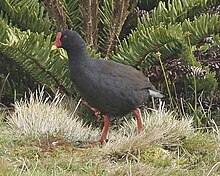| Gough moorhen | |
|---|---|

| |
| on Tristan da Cunha | |
| Conservation status | |
 Vulnerable (IUCN 3.1) | |
| Scientific classification | |
| Domain: | Eukaryota |
| Kingdom: | Animalia |
| Phylum: | Chordata |
| Class: | Aves |
| Order: | Gruiformes |
| Family: | Rallidae |
| Genus: | Gallinula |
| Species: | G. comeri |
| Binomial name | |
| Gallinula comeri (Allen, 1892) | |
The Gough moorhen (Gallinula comeri) is a medium-sized, almost flightless bird that is similar to the common moorhen (Gallinula chloropus), but is smaller, stockier, and has shorter wings. The bird has a distinctive yellow-tipped red bill and red frontal shield. Its first account was written in 1888 by the polar explorer George Comer, whom the specific name comeri commemorates. This bird is found only on two remote islands in the South Atlantic.
The Gough moorhen was originally endemic to Gough Island, but in 1956 was introduced to Tristan da Cunha, an island in the same archipelago which was formerly home of the now extinct Tristan moorhen (Galinula nesiotis). On the basis of DNA sequencing of both recently collected and historical material from both of the archipelago's moorhen species, Groenenberg et al (2008) concluded that the genetic distances between G. nesiotis and G. comeri are of at least the same size as those found between subspecies of common moorhen (G. chloropus) in the literature. They propose that the extinct moorhen of Tristan (G. nesiotis) and the moorhens that live on Gough and Tristan today (G. comeri) be regarded as subspecies.
On Gough Island, it appears that the bird's future is secure with the island being a nature reserve and a World Heritage Site. In the mid-1990s, it was estimated that 2,500 breeding pairs existed on Gough Island. Gough Island is considered the least disturbed, major, cool-temperate island ecosystem in the South Atlantic Ocean and hosts one of the most important sea-bird colonies in the world, containing 54 bird species, 22 breeding species, and four threatened species. However, on Tristan da Cunha, it is not classified as a native species and therefore is not protected.
References
- BirdLife International (2016). "Gallinula comeri". IUCN Red List of Threatened Species. 2016: e.T22692866A93372513. doi:10.2305/IUCN.UK.2016-3.RLTS.T22692866A93372513.en. Retrieved 12 November 2021.
- Roots, Clive (2006). Flightless birds. Westport, Conn.: Greenwood Press. p. 60. ISBN 0-313-33545-1. Retrieved 31 March 2008.
- Beolens, Bo; Watkins, Michael; Grayson, Michael (28 August 2014). The Eponym Dictionary of Birds. Bloomsbury Publishing. p. 284. ISBN 978-1-4729-0574-1.
- Groenenberg, D.S.J., Beintema, A,J., Dekker, R.W.R.J. & E. Gittenberger, 2008. Ancient DNA Elucidates the Controversy about the Flightless Island Hens (Gallinula sp.) of Tristan da Cunha. PLoS ONE 3(3):1835. full text
External links
- BirdLife Species Factsheet.
- ARKive - images and movies of the Gough Island moorhen (Gallinula comeri)
- "Description of a new gallinule, from Gough Island" - J.A. Allen, Bulletin of the American Museum of Natural History, Vol.4, Art.6, 1892. p. 57-58
- Official Gough Island website
- website A.J.Beintema
| Taxon identifiers | |
|---|---|
| Gallinula comeri | |
This Gruiformes-related article is a stub. You can help Misplaced Pages by expanding it. |
This article about Tristan da Cunha is a stub. You can help Misplaced Pages by expanding it. |